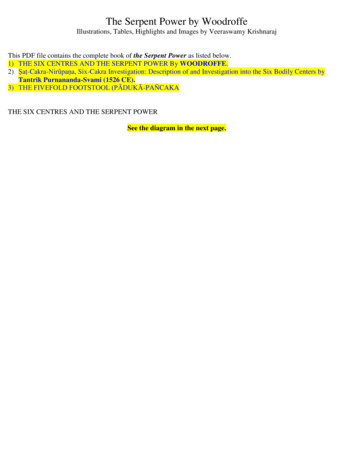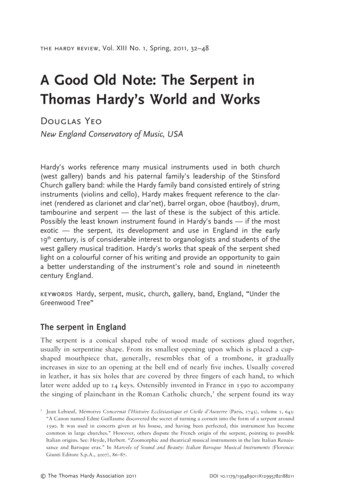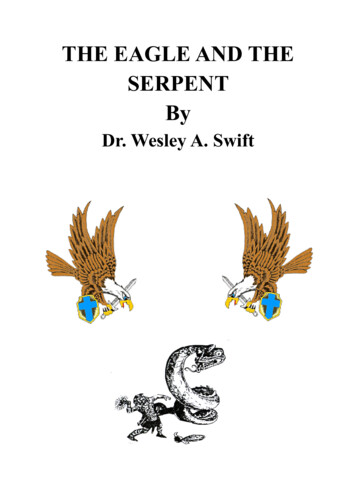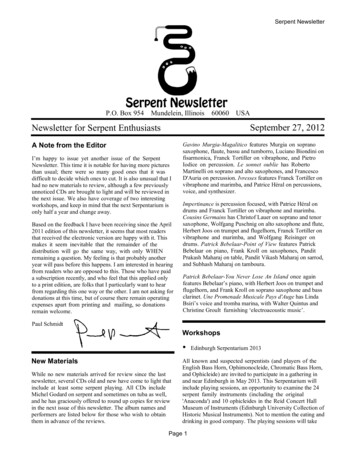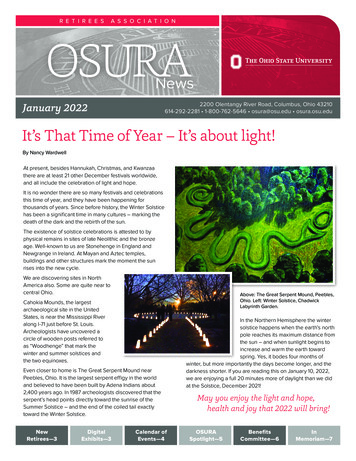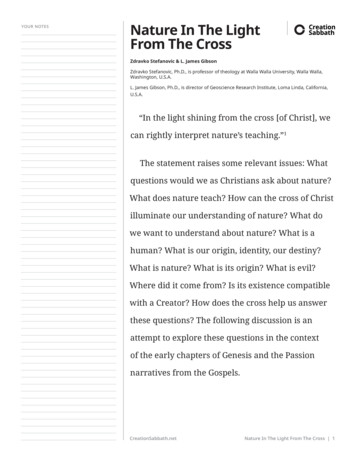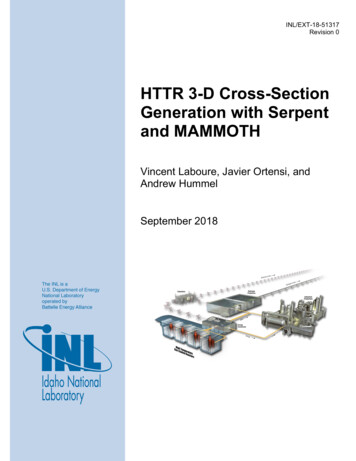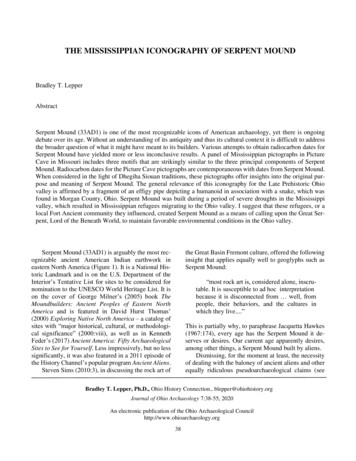
Transcription
THE MISSISSIPPIAN ICONOGRAPHY OF SERPENT MOUNDBradley T. LepperAbstractSerpent Mound (33AD1) is one of the most recognizable icons of American archaeology, yet there is ongoingdebate over its age. Without an understanding of its antiquity and thus its cultural context it is difficult to addressthe broader question of what it might have meant to its builders. Various attempts to obtain radiocarbon dates forSerpent Mound have yielded more or less inconclusive results. A panel of Mississippian pictographs in PictureCave in Missouri includes three motifs that are strikingly similar to the three principal components of SerpentMound. Radiocarbon dates for the Picture Cave pictographs are contemporaneous with dates from Serpent Mound.When considered in the light of Dhegiha Siouan traditions, these pictographs offer insights into the original purpose and meaning of Serpent Mound. The general relevance of this iconography for the Late Prehistoric Ohiovalley is affirmed by a fragment of an effigy pipe depicting a humanoid in association with a snake, which wasfound in Morgan County, Ohio. Serpent Mound was built during a period of severe droughts in the Mississippivalley, which resulted in Mississippian refugees migrating to the Ohio valley. I suggest that these refugees, or alocal Fort Ancient community they influenced, created Serpent Mound as a means of calling upon the Great Serpent, Lord of the Beneath World, to maintain favorable environmental conditions in the Ohio valley.Serpent Mound (33AD1) is arguably the most recognizable ancient American Indian earthwork ineastern North America (Figure 1). It is a National Historic Landmark and is on the U.S. Department of theInterior’s Tentative List for sites to be considered fornomination to the UNESCO World Heritage List. It ison the cover of George Milner’s (2005) book TheMoundbuilders: Ancient Peoples of Eastern NorthAmerica and is featured in David Hurst Thomas’(2000) Exploring Native North America – a catalog ofsites with “major historical, cultural, or methodological significance” (2000:viii), as well as in KennethFeder’s (2017) Ancient America: Fifty ArchaeologicalSites to See for Yourself. Less impressively, but no lesssignificantly, it was also featured in a 2011 episode ofthe History Channel’s popular program Ancient Aliens.Steven Sims (2010:3), in discussing the rock art ofthe Great Basin Fremont culture, offered the followinginsight that applies equally well to geoglyphs such asSerpent Mound:“most rock art is, considered alone, inscrutable. It is susceptible to ad hoc interpretationbecause it is disconnected from well, frompeople, their behaviors, and the cultures inwhich they live.”This is partially why, to paraphrase Jacquetta Hawkes(1967:174), every age has the Serpent Mound it deserves or desires. Our current age apparently desires,among other things, a Serpent Mound built by aliens.Dismissing, for the moment at least, the necessityof dealing with the baloney of ancient aliens and otherequally ridiculous pseudoarchaeological claims (seeBradley T. Lepper, Ph.D., Ohio History Connection., blepper@ohiohistory.orgJournal of Ohio Archaeology 7:38-55, 2020An electronic publication of the Ohio Archaeological Councilhttp://www.ohioarchaeology.org38
Journal of Ohio ArchaeologyVol. 7, 2020Feder 2018), the goal of connecting Serpent Mound toits original cultural context and so rendering it scrutable, depends upon establishing the date of its initialconstruction. Currently there is debate over the antiquity of Serpent Mound with William Romain and hiscolleagues arguing for an Early Woodland (circa 800100 B.C.E.) or Adena culture age (Herrmann et al.2014; Monaghan and Herrmann 2019; Romain 2019;Romain et al. 2017; Romain and Herrmann 2018) andmyself along with my collaborators arguing for a LatePrehistoric (circa 900-1650 C.E.) or Fort Ancient culture age (Fletcher et al. 1996; Lepper 2018a; Lepper etal. 2018; Lepper et al. 2019). This debate has been constructive and hopefully has nudged us closer to aclearer understanding of the age of the original construction of Serpent Mound, but the seeming inabilityto resolve the debate with radiocarbon dates from moreor less problematic contexts suggests that other approaches for dating the mound need to be explored.George Kubler (1962:1) observed that the things madeby humans “mark the passage of time with far greateraccuracy than we know, and they fill time with shapesof a limited variety.” This offers the hope that the history of Serpent Mound may be read in its form.The purpose of this paper is to briefly review thedata and arguments for the age of Serpent Mound thathave been advanced so far; and to offer an extendedargument for a Late Prehistoric age for the effigy basedon iconography. Hopefully, this discussion will inspirefurther debate and, even more hopefully, further investigations that eventually will result in more definitiveanswers to our questions about this “wonderful, mysterious, thought-provoking Serpent Effigy,” which lies“prone upon the plateau, as it has lain for centuries,puzzling the archaeologist, who racks his brain in hisefforts to make it give up its secrets ” (Cole and Mills1921:530).Leppersite. Putnam (1888:51-52) felt the evidence for this occupation included “nothing remarkable” – only “rude”pottery and “no elaborate structures.” Therefore, theseunremarkable people simply could not have been thebuilders of something as elaborate and remarkable asSerpent Mound.James Griffin (1966:57) agreed with Putnam’sopinion of the age of Serpent Mound and evidently forthe same reasons. He flatly stated that "Serpent Mound,the burial mound near it, and the lower levels of thevillage site are Adena" (1978:242). Griffin never offered any evidence to support such a definitiveconclusion, but Mark Seeman, in a tribute to Griffin,recounted an anecdote that appears to confirm a strongprejudice against the Fort Ancient culture as the builders of Serpent Mound. Griffin wrote to Seeman that he“simply couldn’t abide” the idea that Serpent Mound“might be of late prehistoric affiliation” (Brose1997:150).Radiocarbon Dates for Serpent MoundRobert Fletcher et al. (1996) were the first to offeractual data in support of an age assessment for SerpentMound. The team located and reopened one of Putnam’s trenches into the effigy in the expectation oflocating the deposits of “clay, mixed with ashes” thatPutnam (1890:875) described as having been used inthe construction of Serpent Mound. Although theirtrench did not reveal any clay-and-ash layer the teamextracted bulk soil samples from two separate undisturbed portions of the mound that included fragmentsof white oak and ash charcoal, which yielded identicalAMS radiocarbon dates of 920 70 BP (Beta55277/CAMS-3566 and Beta-55278/CAMS-3567).On this basis, Fletcher et al. (1996:133) concluded thatSerpent Mound was constructed by the Fort Ancientculture during the early Late Prehistoric period.Fletcher et al. (1996:132) also obtained a date of2,920 65 B.P. (Beta-47212, ETH-8520) on a smallfragment of charcoal recovered from a soil core, notfrom the exposed profile in the “Fletcher trench” asclaimed by Herrmann et al. (2014:123). The soil corewas extracted in close proximity to where the trenchwas subsequently excavated and the charcoal was froma depth of approximately 132 cm below the surface ofthe mound, which, in the trench profile, would be about70 cm below the base of the mound. The soils beneaththe base of the mound conformed to the expectationsof a typical, if truncated, Bratton silt loam (Fletcher etThe Age of Serpent MoundFrederic Putnam (1888) believed that SerpentMound was built by what later archaeologists wouldrefer to as the Adena culture, the same culture responsible for the nearby large conical burial mound. Heoffered no evidence in support of his belief, only hisopinion that “everything relating to the construction ofthe great earthwork points to antiquity” (1888:52).Reading somewhat between the lines, it appears thatassessment was based on his negative views of the capabilities of the later (Fort Ancient) occupants of the39
Journal of Ohio ArchaeologyVol. 7, 2020LepperPutnam’s observation is, however, corroborated bymultiple lines of independent evidence. First of all,Putnam’s photograph of his excavation around theedge of the Serpent’s tail demonstrates that here, atleast, the A horizon had indeed been removed prior toits construction (Lepper 2018a:63-64; Lepper et al.2019:48). Moreover, since Putnam (1890:875) employed this method of excavation along the edge ofSerpent Mound “throughout” its length, he was able todetermine that “no black soil was used in the construction of the embankment, nor left below it.” That seemsfairly clear. It certainly was clear enough for Griffin(1966:57).Secondly, Frolking extracted additional soil coresin proximity to Herrmann et al.’s (2014) core locationsand his physical descriptions of these cores combinedwith chemical analyses (not done by Monaghan andHerrmann) demonstrate that, in these locations at least,the A horizon had been removed prior to mound construction (Lepper et al. 2019:48-49).As to whether Putnam might have mistaken the Ehorizon for the clay “often mixed with ashes” that henoted at a few places along the effigy, based on the evidence, such an error is highly unlikely. Putnam(1890:875) suggested the clay and clay-and-ash mixture were used to help stabilize the effigy in placeswhere it might have been particularly susceptible toerosion. Since Putnam (1890:875) excavated along theedge of Serpent Mound “throughout” its length, if theclay “mixed with ashes” was actually the E horizon andif it was present across all or much of the length of theeffigy, then Putnam would have observed it in morethan a few locations. The fact that he observed the clay“mixed with ashes” only in isolated locations meansthat it was either clearly distinct from the supposedlymore widespread E horizon, or, if it was localized remnants of the E horizon, then across the majority of theeffigy’s length the E must have been removed alongwith the A horizon. In either case, Monaghan andHerrmann’s claim that there is an intact A horizon beneath Serpent Mound is not substantiated and theradiocarbon dates they obtained on bulk soil organics(not charcoal in spite of their repeated misleadingclaims to the contrary) recovered from at and near thebase of Serpent Mound cannot be demonstrated to haveany direct relationship to the age of its original construction. And moreover, regardless of the problematicprovenience of the dated samples, it is well establishedthat radiocarbon dates obtained on “bulk sediment organics” are “usually inaccurate” (Waters et al. 2018:1).al. 1996:132). There is no evidence in the exposed profile of soil material having washed in, slumped in, orbeen intentionally deposited in order to fill the gullythat Herrmann et al. (2014:123) propose had developedacross the mound in this location sometime after itsconstruction during the Early Woodland period andwhich supposedly necessitated a repair during the LatePrehistoric period. Therefore, the charcoal fragmentwas likely intruded into this level either by bioturbation or by the displacement of material associated withthe extraction of the soil core. In either case, it is out ofcontext and bears no demonstrable relevance to the ageof the original construction of Serpent Mound.Excavations conducted by ASC Group, Inc. in2011, in an area north of the large Adena conicalmound, uncovered a buried A horizon beneath fill associated with late nineteenth or early twentieth centurylandscaping (Schwarz and Lamp 2012:53). The teamrecovered hickory charcoal fragments from this layerthat yielded a radiocarbon date of 900 25 BP(UGAMS 9540) (Schwarz, this volume). The closecorrespondence of this date for the Late Prehistoric occupation and the Fletcher et al. (1996) dates for SerpentMound supports the interpretation that the constructionof the mound and the occupation of the village werecoterminous.In 2011, Herrmann et al. (2014:119) sought to“reevaluate when and how Serpent Mound was built”and to that end extracted 18 soil cores from across theeffigy. The team submitted samples of organic sediment from at or near the base of the mound forradiocarbon dating and obtained nine AMS radiocarbon dates ranging in age from 2170 30 BP (Beta337163) to 2530 30 BP (Beta-337166). They concluded that Serpent Mound was “initially constructed2,300 years ago during the Early Woodland (Adena)period” (2014:124). One significant problem with thisclaim is that they failed to consider Putnam’s observation (1890:875) that the builders of Serpent Moundremoved the A horizon prior to constructing the effigy(see also Griffin 1966:57); an observation corroboratedby Lepper et al. (2018 and 2019).Monaghan and Herrmann (2019:88) answered thisconcern with the simple assertion that their interpretation of their soil cores “belies Putnam’s statements thatthe surface was stripped prior to mound construction.”They proposed that “Putnam’s notion of surface stripping likely derived from the erroneous identification ofthe E horizon as an ‘ashy’ layer” (Monaghan andHerrmann 2019:90).40
Journal of Ohio ArchaeologyVol. 7, 2020Herrmann et al. (2014:124) argued that the overallconsistency in the radiocarbon dates they obtainedfrom different cores extracted at various locationsalong the effigy mound supports their interpretationthat Serpent Mound was built during the Early Woodland period. This argument, however, rests upon thefallacy of conflating precision with accuracy. If thedates all are skewed by the same mechanical, geochemical, or pedogenic processes, then they could allbe wrong to the same degree and in the same direction.Thus, for a variety of reasons, the radiocarbon datesobtained by Herrmann et al. (2014) cannot be demonstrated to be directly relevant to the age of the originalconstruction of Serpent Mound and, as Herrmann et al.(2014:121) originally conceded, “the mound couldhave been constructed any time after 300 BC.”Herrmann et al. (2014:122) suggested that the radiocarbon dates obtained by Fletcher et al. actuallyrelated to a Fort Ancient culture restoration of a supposedly extensively eroded section of an AdenaSerpent Mound (see also Romain et al. 2017). Elsewhere, I have addressed the principal problems withthis supposition, which I characterized as a “just-sostory offered to account for the otherwise inconvenientLate Prehistoric radiocarbon dates” (Lepper 2018a:65;see also Lepper et al. 2018:438).Romain et al. (2017:11-12) proposed that the discovery by Jarrod Burks (2012) of a supposed “‘erased’convolution at the neck of the serpent” provided additional support for their supposition arguing that, since“at least one episode of prehistoric modification occurred, there is no reason to think that anotherepisode could not also have occurred.” This argument assumes that the magnetic anomaly identified byBurks is related to a subsequently removed segment ofSerpent Mound, though it is by no means clear that thisis the correct interpretation of the anomaly. It furtherassumes that the original form of the mound, which included the supposed additional convolution, was anAdena design that was later altered by the Fort Ancientculture. Even if the magnetic anomaly represents achange made to the original design of the effigy, thereis no evidence to indicate when that change was made.It would be just as plausible to argue that the originalbuilders, whoever they were, made a decision to alterthe design during some stage of the original construction process. Therefore, based on the currentlyavailable data, the magnetic anomaly suggestive of an“erased” convolution provides no corroborating support for the notion that the Fort Ancient cultureLeppermodified an already ancient and degraded SerpentMound.The most recent attempt to obtain radiocarbondates for the construction of Serpent Mound occurredduring the 2017 removal of the CCC-era stone stairs,which extended over the tail of Serpent Mound (seePickard et al. 2018; see also Lepper et al. 2019). Theremoval of the steps exposed what Pickard et al. interpreted as intact mound strata from which they obtaineda radiocarbon date on soil humates of 720 30 BP(Beta-470763); and two AMS radiocarbon dates ontwo fragments of oak charcoal: 1263 22 BP (AA110452) and 1300 30 BP (Beta-473077). The dateson particulate wood charcoal, which overlap at onestandard deviation, can provide only a maximum ageestimate for the mound. The charcoal may be from oldwood or it may have come from Late Woodland features that were inadvertently dug up by the FortAncient inhabitants of the site and incorporated intothe mound fill. The dates are not inconsistent with aFort Ancient culture attribution but are definitely inconsistent with an Adena age. The soil humates date isproblematic because more recent humates can contaminate upper soil layers. It does, however, provide anapproximate minimum age for the construction of Serpent Mound.The relative merits of these various attempts to obtain radiocarbon dates for Serpent Mound are debatedin a series of publications (Herrmann et al. 2014; Lepper 2018a; Lepper et al. 2018; Lepper et al. 2019;Monaghan and Herrmann 2019: Romain 2019; Romain et al. 2017; Romain and Herrmann 2018). It isclear, however, that neither the dates on particulatecharcoal from mound fill, nor dates on bulk soil organics from a truncated soil horizon, are able bythemselves to establish a definitive age for SerpentMound.Iconography of Serpent MoundLepper et al. (2018) argued that the MacLean(1885; Figure 1) and Holmes (1886) maps of SerpentMound are the most accurate representations of theoriginal form of the effigy. Based on these maps, thereare three main components to Serpent Mound: (1) theserpent itself; (2) a large oval embankment sometimesinterpreted as an egg in the mouth of the serpent or asthe serpent’s heart, eye, or gaping mouth; and (3) awishbone-shaped embankment, which MacLean suggested might represent a frog (1885:45).41
Journal of Ohio ArchaeologyVol. 7, 2020LepperFigure 1. The John P. MacLean (1885) map of Serpent Mound is the earliest map to show certain features that often areomitted from discussions of the effigy, including the wishbone-shaped earthwork, which he interpreted as a separate effigy ofa frog.Lepper et al. (2018) concluded that a panel of pictographs at Picture Cave in Missouri included thesesame three motifs (Figure 2), which Carol Diaz-Granádos and her colleagues (2015) interpreted as (1) theGreat Serpent, Lord of the Beneath World; (2) an ovalrepresentation of the serpent’s open mouth or a vulvoid; and (3) First Woman, also known as OldWoman-Who-Never-Dies, who is the “mother of allliving things” in the traditions of the Dhegihan Sioux(Duncan and Diaz-Granádos 2018b:66).Further corroboration of the relationship betweenthe Picture Cave pictographs and Serpent Mound isprovided by the correspondence between a pair ofbulbous protuberances at the neck of Serpent Mound(see Figure 1) and similarly placed, blocky projectionsalong the neck of another image of the Great Serpenton a separate panel at Picture Cave (Lepper et al.2018:443). The Serpent Mound protuberances havebeen interpreted variously as wings (MacLean1885:46) or horns (Willoughby 1919:162). Theanalogous features in the Picture Cave pictograph,however, bear a marked resemblance to earspools(Lepper et al. 2018:443), which suggests a more plausible interpretation for the Serpent Mound features.This particular pictograph produced an AMS radiocarbon date of 950 100 BP (CAMS-41465) (DiazGranádos et al. 2001:489), which is virtually identicalto the dates of 920 70 BP obtained by Fletcher et al.(1996) for Serpent Mound. These iconographic andchronometric correspondences suggest that the PictureCave glyphs may serve both to help situate SerpentMound in time and provide a contemporary and parallel “visual text” (Boyd 2016:30) to shed light on theoriginal meaning of the iconography of SerpentMound.Kent Reilly and the other members of the Mississippian Iconography Conference, including JamesDuncan and Carol Diaz-Granádos, have developed andrefined the use of indigenous traditions as recorded inthe ethnohistoric and ethnographic literature to42
Journal of Ohio ArchaeologyVol. 7, 2020interpret the artistic motifs of the Mississippian Ideological Interaction Sphere (Steponaitis 2007). Reillyand colleagues see individual motifs or tableaus engraved on shells or painted on a cave wall as analogousto “clippings from a 1920s silent film . The editedclips in several instances contain enough cells for theviewer to recognize some of the film sequences even ifthe full story is not evident” (Reilly III and Garber2011:311). They argue that these separate images canbe viewed as frames within a narrative sequence(Brown 2007:75). In order to identify the dramatis personae of those narratives and to fill in the narrativesequence, Reilly and colleagues refer to the deepknowledge, acquired over decades of painstaking research, of the traditional stories of groups indigenous,or at least with close geographic ties, to the regions inwhich the particular artistic motifs occur. Lepper et al.(2018) applied this method to the interpretation of Serpent Mound and concluded that the Picture Cave paneland Serpent Mound are telling the same or a closelyrelated story. Although the compositions of the pictograph panel and Serpent Mound clearly are notidentical, they can be viewed as separate but relatedframes from the same narrative sequence recording“the moment when First Woman bridges the cosmos,bringing the life-giving powers from the BeneathWorlds to the Middle World, the Earth” (Lepper et al.2018:446).Diaz-Granádos et al. (2015) associated the PictureCave pictographs with the ancestors of the DhegihanSioux, but this does not necessarily mean that the ancestors of the Dhegihan Sioux built Serpent Mound.There is clear historical evidence that Siouan groupslived in the Ohio valley in the early historic era (Cook2017:17) and the traditions of some Dhegihan tribes attest that this region was, indeed, their homeland(Henning 1993). But other groups lived in the regionas well and it may simply be that the rich ethnographicrecord of the Dhegihan tribes, especially the Omaha,preserve elements of traditions that once were sharedmore widely, but subsequently have been lost for various historic reasons in other tribes. The Shawnee, forexample, also have traditions relating to a female creator with many of the characteristics of First Woman(Prentice 1986:249-254) and formerly had a SnakeClan (Spencer 1909:321). As a result, it may not bepossible to culturally affiliate Serpent Mound with anyparticular modern American Indian tribe.With regard to the wishbone-shaped earthwork atthe head of Serpent Mound, Romain (2019:60) statesLepperFigure 2. A portion of Panel 3 from Picture Cave, Missouri,showing the three glyphs that correspond to the three principal elements of Serpent Mound as mapped by MacLean.The Great Serpent (Glyph 67), First Woman (Glyph 64),and the large oval vulvoid (Glyph 59) (Diaz-Granádos et al.2015). These images are thought to be associated in a singlecomposition not just because they are adjacent to one another, but also because they appear to have been paintedwith the same pigment and application technique. Drawingby Peter Lepper.categorically that “there are no embankments flankingthe anterior aspect of the oval that might be interpretedas frog legs.” Yet these features were independentlyobserved and documented by MacLean (1885),Holmes (1886), and Willoughby (1919). Putnam alsodescribed them: “between the oval figure and the edgeof the ledge there is a slightly raised circular ridge ofearth [the body of MacLean’s “frog”], from either sideof which a curved ridge extends towards the sides ofthe oval figure” (Putnam, quoted in American Antiquarian Society 1884:11, emphasis added; see also twoof Putnam’s early plans of Serpent Mound, whichclearly show these embankments [Putnam n.d. andWilloughby 1919:Plate XIc, facing page 158]). Ultimately, however, Putnam decided to follow EphraimSquier and Edwin Davis in ignoring these embankments, which appeared to complicate if not contradicttheir preferred interpretation of the effigy as a serpent43
Journal of Ohio ArchaeologyVol. 7, 2020swallowing an egg (Lepper et al. 2018:8). Seen in thislight, Putnam’s decision not to restore the features thathe and others documented is therefore not credible evidence of their absence, but rather an example of“experimenter expectancy, or seeing what you want tosee” (Broad and Wade 1982:107).Romain (2019:74) also wants to see the Great Serpent in the act of swallowing something; however, heinterprets the oval earthwork as a representation of thesun rather than an egg and offers an unconvincing justification for why the ancient American Indian buildersdepicted a round sun as an oval. Romain’s interpretation makes MacLean’s “frog” just as inconvenient forhim as it was for Squier, Davis, and Putnam. So, ofcourse, he also would like to make it go away.In an effort to justify this erasure, Romain(2019:60-61) turned to LiDAR imagery to confirm thatthere are no “embankments or embankment remnantsextending from the jaws of the serpent around theoval.” LiDAR, however, can show only what is, or isnot, there now, not what was there prior to Putnam’sextensive excavations, restorations, and the construction of the paved path around the oval earthwork. I donot dispute Romain’s LiDAR results, but the obviousfact that the embankments are not there now is duesolely to Putnam’s decision not to restore them.LepperMississippian/Late Prehistoric period. It depicts thelower torso and legs of a naked, kneeling humanoidfigure with a serpent extending across its back from theleft shoulder to the right buttock (Figure 3). Althoughfragmentary, on the basis of comparisons to the Birgerfigurine in particular, it may be part of another iconicrepresentation of First Woman and the Great Serpent.The Morgan County pipe appears to have been deliberately broken “fitting the pattern of ceremonial‘killings’ of Mississippian statues and effigies” (Prentice 1986: 248).Squier and Davis (1848:248) documented a somewhat similar pipe found “on the banks of Paint creek,one mile distant” from Chillicothe in Ross County,Ohio. It was carved from a “compact reddish sandstone” and appears to represent a quadrupedal creature,though the “limbs are barely indicated,” with a humanhead and a large serpent draped around its neck. Theserpent’s head and tail are “resting together upon thebreast of the figure.”The recently described Vaux pipe, supposedlyfound in Cumberland, Virginia, and therefore also “atthe periphery of the Mississippian world” (Veit andLobiondo 2018:56), was carved from a “fine-grainedsedimentary stone, likely sandstone” (Veit and Lobiondo 2018:55). It depicts a “zoomorphic creature: inpart a kneeling chunkey player and in part a taloned,rattlesnake-wrapped being that may be a Birdman, aGreat Serpent, or a Great Panther” (Veit and Lobiondo2018:41).Although these other pipes do not appear to depictFirst Woman, they show the Great Serpent in association with other figures from the “pantheon ofsupernatural beings” that is characteristic of Mississippian iconography (Duncan and Diaz-Granádos2004:215). And while it is regrettable that so little ofthe Morgan County pipe has been recovered and thatthere is no information regarding its specific provenience, its presence in southeastern Ohio corroboratesthe importance of these mythic figures in the traditionsof at least some of the Late Prehistoric peoples livingin the Ohio valley.A Possible Representation of First Woman and theGreat Serpent on a Fragmentary Stone Pipe from OhioThe Mississippian iconography supporting the interpretation of Serpent Mound as First Woman and herconsort the Great Serpent derives almost exclusivelyfrom the Mississippian heartland in the MississippiRiver valley and southeastern North America. Amongthe most important representations are ceramic andstone sculptures of a kneeling woman often interactingwith a serpent, such as the Birger figurine found in thevicinity of Cahokia (Duncan and Diaz-Granádos2018b; Emerson 1982; Prentice 1986). The apparentabsence of such representations from the Ohio valleymight be thought to suggest that this iconography wasnot a part of the traditions of the cultures indigenous tothis region and so any similarities to Serpent Moundcould be dismissed as coincidental and therefore irrelevant to an understanding of its form and meaning.The collections of the Ohio History Connection,however, include a fragment of a sandstone pipe fromMorgan County, Ohio, which, based on its form andsubject matter, is considered to date to theGetting to the Original Purpose and Meaning ofSerpent Mound‘The historical past was real, but the evidencethat survives of it can be distorted and disconnected, like a shadow cast on a field of rocks.The evidence includes traditions often44
Journal of Ohio ArchaeologyVol. 7, 2020LepperFigure 3. Fragment of a Late Prehistoric period sandstone pipe found in Morgan County, Ohio, depicting a naked, kneelinghuman figure with a serpent extending diagonally across its back. The regrettably small portion of the sculpture that remainsis consistent with other Mississippian representations of First Woman and her consort, the Great Serpent (Duncan and DiazGranádos 2018b:68). William Hook collection, Ohio History Connection (A76/001).imperfectly transmitted between generations;ceremonies whose symbolism has changed tobecome supportive of new values; origin mythsnaturalized to new locations; ceremonial objects whose full significance was known only toelders who have died; the bones of Indianswhose deaths silenced personal stories thatawait telling; buried artifacts that speak of technolog
Mound. Radiocarbon dates for the Picture Cave pictographs are contemporaneous with dates from Serpent Mound. When considered in the light of Dhegiha Siouan traditions, these pictographs offer insights into the original pur-pose and meaning of Serpent Mound. The general re
